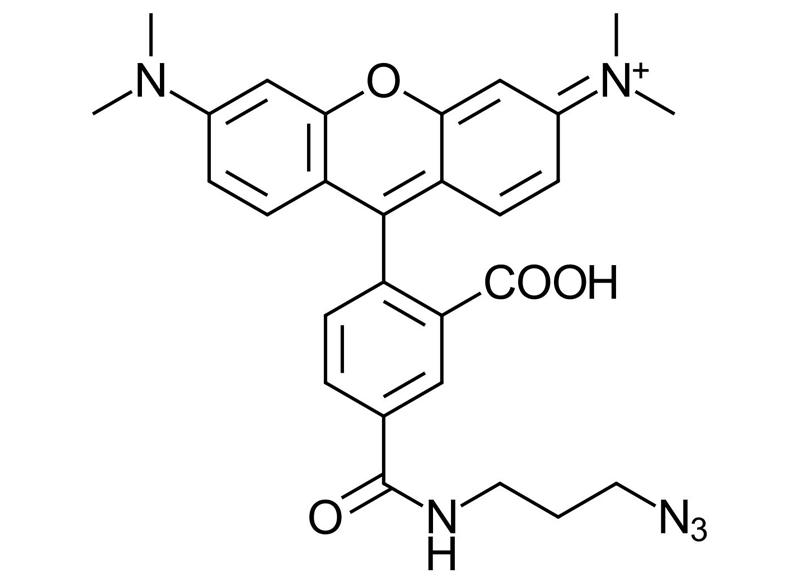5-Carboxytetramethylrhodamine Azide (5-TAMRA-Azide)
TAMRA fluorescent dye to label DNA/RNA

| Size | Catalog No. | Price |
|---|---|---|
| 5 mg | BCFA-008-5 | € 100,00 |
| 10 mg | BCFA-008-10 | € 150,00 |
-
5-Carboxytetramethylrhodamine Azide (5-TAMRA-Azide) is a reporter reagent that allows efficient fluorescent labeling of nucleic acids by click bioconjugation. It is often used as FRET-acceptor in combination with FAM. Just like many rhodamine-based dyes, it is quite photostable between pH 4 and 9. It shows identical spectral properties to Alexa Fluor® 555 or DyLight 549 dyes.
LITERATURE
Postsynthetic DNA Modification through the Copper-Catalyzed Azide–Alkyne Cycloaddition Reaction, P. M. E. Gramlich et al., 2008, Angew. Chemie Int. Ed., Vol. 47, p. 8350–8358.
https://doi.org/10.1002/anie.200802077
Click–Click–Click: Single to Triple Modification of DNA, P. M. E. Gramlich et al., 2008, Angew. Chemie Int. Ed., Vol. 47, p. 3442-3444.
https://doi.org/10.1002/anie.200705664
A chemical method for fast and sensitive detection of DNA synthesis in vivo, A. Salic et al., 2008, Proc. Natl. Acad. Sci. U. S. A., Vol. 105, p. 2415–2420.
https://doi.org/10.1073/pnas.0712168105
Fluorescent labelling of in situ hybridisation probes through the copper-catalysed azide-alkyne cycloaddition reaction, S. Hesse et al., 2016, Chromosome Research, Vol. 24, p. 299–307.
https://doi.org/10.1007/s10577-016-9522-z
Genetic Encoding of a Bicyclo[6.1.0]nonyne-Charged Amino Acid Enables Fast Cellular Protein Imaging by Metal-Free Ligation, A. Borrmann et al., 2012, ChemBioChem, Vol. 13(14), p. 2094-2099.
https://doi.org/10.1002/cbic.201200407
New insights into the intracellular distribution pattern of cationic amphiphilic drugs, M. Vater et al., 2017, Scientific Reports, Vol 7, p. 44277.
https://doi.org/10.1038/srep44277
The Cyanobacterial “Nutraceutical” Phycocyanobilin Inhibits Cysteine Protease Legumain, I. V. L. Wilkinson et al., 2022, ChemBioChem, Vol. 24(5), p. e202200455.
-
-
Molecular Formula
C28H28N6O4
-
Shelf Life
12 months unopened after receipt
-
Storage Conditions
-20 °C, dark
-
Molecular Weight
512.56 g/mol
-
Purity
≥ 95% (LCMS)
-
Physical State
pink to dark red colored solid
-
CAS Number
1192590-89-8
-
Additional name
5-TAMRA-Azide; 5-Carboxytetramethylrhodamine Azide, 5-((3-Azidopropyl)carbamoyl)-2-(6-(dimethylamino)-3-(dimethyliminio)-3H-xanthen-9-yl)benzoate
-
Excitation (max)
DMSO or DMF: 546 nm
-
Emission (max)
DMSO or DMF: 579 nm
-
Ɛ (max)
DMSO or DMF = 91,000 cm-1M-1
-
Solubility
DMSO, DMF, MeOH
-
Preparation/Handling
For a 10 mM solution add 195 μL to 1 mg.
-
Molecular Formula

